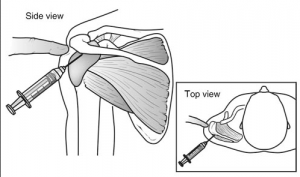75% of rehabilitative therapy for sports injuries is the shoulder joint. Lately non-sports injuries have seen a rise in shoulder injury from the computer in office workers. As the shoulder is one of the more complex joints of the body, it is an area that is commonly injured as it’s the most movable joint in a patient’s body.
What causes shoulder pain?
Pain in the shoulder is a worry and can be from many sources, as the shoulder complex is made of muscle, tendon, ligament, and bone. Luckily many do not need surgery. There are many terms for shoulder pain, they may include:
- frozen shoulder

- rotator cuff injury
- adhesive capsulitis
- tendinitis
- shoulder arthritis
- bursitis
- labral tear
How does the patient have shoulder pain diagnosed?
Physical examination is the primary mode of diagnosis. Board Certified Arizona workers compensation doctors such as Dr. Adarmes are experts at shoulder pain evaluations.
With subsequent imagery through x-ray, arthrogram, mri or diagnostic injection, a patient’s physician will determine a treatment program and course of action. Usually the first course of treatment is an anti-inflammatory medication to lessen the pain and pressure on the injury.This may also include a steroid injection into the shoulder for relief.
Treatments for shoulder pain
Anti-inflammatory medicine is usually the first step in any shoulder injury. Physical therapy using ultrasound and electrical stimulation will be used to increase blood flow. Stretching and strengthening exercises will be added in a gradual manner, cortisone steroid shots are used to administer medicine by injection.
- physical therapy including ultrasound and electrical stimulation
- chiropractic therapy and acupuncture
- massage therapy
- Electric stimulation therapy
- short term bracing
How effective is shoulder pain treatment? Are they safe?
Studies shows 75% of patients who received treatment at an early stage of their injury  showed improved non-surgically with physical therapy alone. Functional improvement and strengthening exercises improved mobility or alleviated symptomatic pain. Physical therapy also seemed to reduce the need for pain blocks, prescribed medications, and correctional surgery with acute cases.
showed improved non-surgically with physical therapy alone. Functional improvement and strengthening exercises improved mobility or alleviated symptomatic pain. Physical therapy also seemed to reduce the need for pain blocks, prescribed medications, and correctional surgery with acute cases.






Leave A Comment